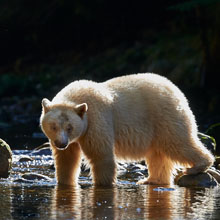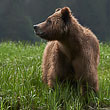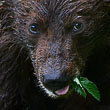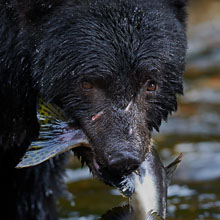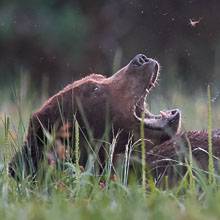Availability: Undetermined - Enquiries?
In the Field
Wet Behind the Ears. Khutzeymateen Grizzly Sanctuary (northern Great Bear Rainforest), BC, Canada. June 1, 2012.
Wet behind the ears? Yep, and everywhere else too! I captured this image of a very curious and very wet grizzly cub way back in the late spring of 2012. This young bear is entering its second spring, and - like the saying "wet behind the ears" would suggest, he's still shy on experience and still figuring out the world at large. That includes what he can, and can't, eat. I watched this cub as he sat back and watched his mom eat some leaves - shortly thereafter he pulled a true "monkey-see, monkey-do" and started eating the same type of leaves. And, of course, as I snapped this image I'm sure this guy was trying to figure out if the creature in front of him (the one with the massive shiny eye pointed at him) was friend or foe. What I'd give to understand what he was thinking while staring at me...
Pulling off an effective tightly-framed portrait of any wild animal is tricky, and about a lot more than just getting close to them. Some of the problems and issues to address in creating an effective portrait involve making camera adjustments that have both technical and creative consequences. Picking an appropriate aperture and depth-of-field is one of the most critical adjustments the photographer can make (and control). In this case I wanted to ensure that eyes, snout, nose, forehead hair, and the leaves were tack sharp, but I simultaneously wanted the upper legs and visible portions of the rest of the body to fall-off in sharpness (effectively ensuring that the viewer's eyes would be drawn to the critical portions of the image). I was helped out a little by the positioning of the bear's head - most of the "must be sharp" regions were on the same plane and close to equidistant to the image sensor of my camera...so I could get away with opening up the aperture only "moderately" (in this case f6.3) and avoid using a crazy ISO (and selecting a slower shutter speed wasn't a real option as I was hand-holding a pretty big lens for this shot - a 400mm f2.8).
How did I know f6.3 would do the trick? Well...a lot of it was experience and "gut feel" - I shoot the 400mm f2.8 lens a lot and have a good working understanding of its characteristics and nuances. And some of it was because I have memorized a number of key distance-to-subject/lens/aperture/DoF combinations (i.e., portions of DoF tables) to guide me in the field. It wasn't like this guy was going to give me a second chance or third chance to get this shot right (via bracketing my apertures and DoF)...I had to get it right the first time, and having a good feel for the DoF as I was shooting was essential for this.
On the creative end of the spectrum, I LIKED the fact the cub was soaking wet - it was just one more little thing to interest and engage the viewer. This little fellow was wet because it was raining out, and the soft, diffuse light associated with the overcast skies I shot this under also helped by killing excessive harshness and contrast and, in doing so, brought out the beautiful tones and hues in the cubs fur (for this reason I commonly think "watch for portrait opportunities" when I'm working with wildlife during rainy or misty conditions). And, of course, I loved the flash of contrasting colour provided by the leaves and tongue (though catching the tongue was as much good luck as management on my part - the cub was chewing when I shot this and the tongue was visible only for fractions of a second). Finally, positioning of the key elements of the image (e.g., eyes, tongue, leaves) in the "right" place within the frame - even in a tight portrait like this - is always critical to making the image work.
ADDITIONAL NOTES:
1. This image - in all resolutions - is protected by copyright. I'm fine with personal uses of them (including use as desktop backgrounds or screensavers on your own computer), but unauthorized commercial use of the image is prohibited by law. Thanks in advance for respecting my copyright!
2. This image was captured during one of my two spring "Grizzlies of the Khutzeymateen" photo tours in May/June of 2012. Each year I offer trips into two different parts of the Great Bear Rainforest as well as one to photograph aquatic mammals and oceanscapes near the northern tip of Vancouver Island. And, in selected years, I also offer photo tours to locations to capture other highly sought-after subjects, such as various boreal owl species and wildlife of Canada's Arctic. Details about these trips can be found on the Photo Tours page of this website.
3. Like all wildlife photographs on this website, this image was captured following the strict ethical guidelines described in The Wildlife FIRST! Principles of Photographer Conduct. I encourage all wildlife photographers to always put the welfare of their subjects above the value of their photographs.
Behind the Camera
Wet Behind the Ears. Khutzeymateen Grizzly Sanctuary (northern Great Bear Rainforest), BC, Canada. June 1, 2012.
Digital Capture; Compressed RAW (NEF) 14-bit format; ISO 720.
Nikon D4 paired with Nikkor 400mm f2.8 VR lens. Hand-held from floating Zodiac inflatable boat. VR on and in "Normal" mode.
1/400s @ f6.3; -0.67 stop compensation from matrix-metered exposure setting.
At the Computer
Wet Behind the Ears. Khutzeymateen Grizzly Sanctuary (northern Great Bear Rainforest), BC, Canada. June 1, 2012.
RAW Conversion to 16-bit TIFF, including first-pass/capture sharpening using Capture One Pro version 6. Four raw variants (different versions of a single raw capture, differing by a total of 1.25 stops in exposure) processed.
Further digital corrections on resulting 16-bit TIFF files using Adobe's Photoshop CS6 and Light Craft's LightZone. Photoshop adjustments included compositing (blending) of the four exposure variants, minor selective exposure adjustment and sharpening for web output. Final tone tweaking performed using tonemapper/re-light tool in LightZone.
Conservation
Wet Behind the Ears. Khutzeymateen Grizzly Sanctuary (northern Great Bear Rainforest), BC, Canada. June 1, 2012.
Ten percent of the revenue generated by this image will be donated to Raincoast*.
Species Status in Canada**: Special Concern (May 2002).
While Grizzly Bears (Ursus arctos) are not technically listed as "Endangered" in Canada, they have been extirpated from most of their historical range. Grizzly Bears are far more sensitive to intrusion/disturbance in their habitat than are Black Bears and are being increasingly forced into marginal habitat by human encroachment. The Great Bear Rainforest along the central and northern coast of British Columbia is one of the last strongholds of the Grizzly Bear in Canada, and even this population is coming under increasing pressure.
On December 18, 2017 the government of British Columbia banned grizzly hunting across the entire province. This major conservation victory came after decades of tireless work by many dedicated conservationists and ecologists and, most importantly, it reflects the opinion of the vast majority of British Columbians. And, it means that AT LEAST while the current government remains in power grizzlies are finally "safe" in British Columbia.
Now that we've at least temporarily won the battle to save grizzlies in BC, it's time to re-focus our efforts toward protecting ALL of BC's carnivores, including Gray Wolves, Black Bears, Cougars, Wolverines, and more! Simply put, there are no ecological, economic, or ethical arguments supporting the trophy hunting of carnivores.
In a great first step towards ending the hunting of carnivores throughout BC the Raincoast Conservation Foundation has developed a program designed to protect ALL carnivores within the Great Bear Rainforest. Details about this program can be found on this page on Raincoast's website. Check it out and, better yet, make a donation to help Raincoast purchase the remaining commercial hunting tenures in the Great Bear!
*The Raincoast Conservation Society (and Foundation) is an effective and efficient organization that has been fighting for protection of this unique habitat. If you are looking for a meaningful way to contribute to the conservation of this amazing ecosystem, Raincoast will provide maximal "bang" for your conservation dollars.
**as determined by COSEWIC: The Committee on the Status of Endangered Wildlife in Canada



















